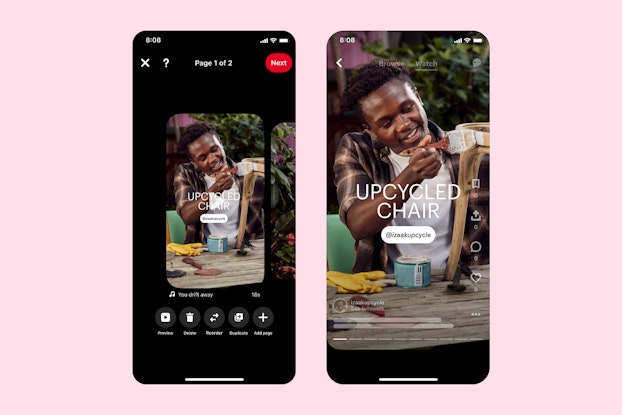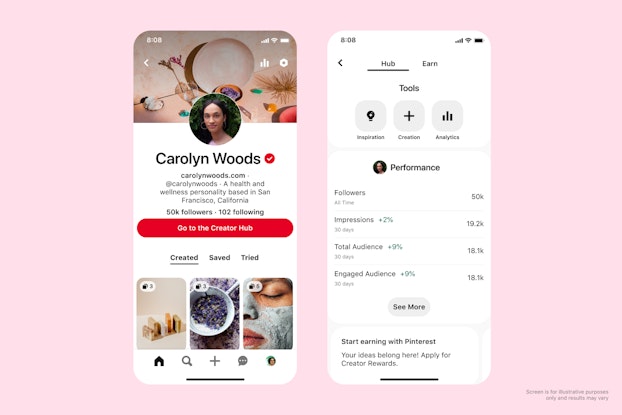
Why it matters:
- The ‘creator economy’ refers to the ever-expanding class of small businesses and entrepreneurs including artisans, influencers and digital content creators that’s become a $104.2 billion business.
- The trend reflects a growing appetite for products and services with a patina of uniqueness and personalization, particularly among younger consumers.
- Against that backdrop, brands like Pinterest and Shutterfly are tapping into the creator economy for growth, just as new platforms such as Pietra and Lumanu are helping creators scale their businesses.
The “creator economy” refers to the ever-growing class of small businesses and entrepreneurs including artisans, influencers and digital content creators. It emerged out of the internet’s natural tendency toward decentralization: With more platforms for sharing and selling, more individuals have been able to create and sell their own goods, or monetize their own digital content.
As the internet helps level the playing field between mega brands and small businesses, brands from Pinterest to Shutterfly are moving to stoke growth via the estimated $104.2 billion creator economy made up of entrepreneurs, startups and influencers.
At the same time, new tech platforms like Pietra are helping creators set up shop and scale their businesses.
“The rise of social media's mass adoption over the past 15 years has led to the democratization of popular opinion,” Jeremy Jankowski, home and design creator lead for Pinterest, told CO—. “Independent voices are now just as large as conglomerate media companies…even how small businesses operate has significantly changed forever.”
In turn, social media and other digital platforms are tapping into the creator economy opportunity by developing tools to support individual creators and are working toward delivering an experience that is rewarding for both creator and customer.

Stoking the creator economy to woo Gen Z, which is poised to wield big spending power
The rise of the creator economy reflects a shift in how users consume content and buy goods, appealing to today’s consumer, particularly younger ones, who value qualities like uniqueness and personalization.
Generally found to be less brand loyal than their older counterparts, younger consumers are also more interested in purchasing from individual sellers than other demographic cohorts: While 27% of consumers reported purchasing from an individual seller over the past year, that number increased to 45% for Generation Z, according to data collected by Forerunner Ventures, and marketers should take note: Born between 1997 and 2012, Gen Z is predicted to become the nation’s largest consumer cohort by 2034, according to a Morgan Stanley report.
[Read: Brands Leverage Diversity-Driven Marketing and Authentic Engagement to Court Gen Z]
How new shoppable ‘Pins’ help brands and small businesses monetize unique content
As the boundaries between social media and commerce continue to blur, tech platforms are giving their creators new tools to turn engagement into seamless purchase experiences. Visual search engine Pinterest, in particular, is working toward making the platform an even more active experience for its more than 400 million active monthly users.
This year, Pinterest launched Idea Pins, a new multi-page video format where anyone with a business account can interact more directly with their audience. According to Pinterest, these new Idea Pins are more actionable than standard Pins, illustrated by the fact that they earn nine times the average comment rate.
A business’s —or creator’s — Idea Pins can garner a massive number of views and high engagement levels for simply being “good, teachable and inspiring content,” Jankowski said, explaining that it relieves the pressure on “Pinners” to focus on gaining followers in order to succeed. “We find [this] helps to diversify the kinds of creators we have on the platform.”
Creators now have the option to make Idea Pins automatically shoppable. Supported by affiliate links and brand sponsorships, creators make a commission on the sale. Research shows shoppers who visit Pinterest weekly outspend non-Pinners every month and have an 85% larger basket size, Jankowski said.
The rise of social media's mass adoption over the past 15 years has led to the democratization of popular opinion. Independent voices are now just as large as conglomerate media companies…even how small businesses operate has significantly changed forever.Jeremy Jankowski, home and design creator lead, Pinterest
Shutterfly: Helping every user feel like an artisan
Shutterfly, an early pioneer of digital content creation, started out as an online photo-sharing site. It has since grown to become a family of brands for the exchange of user-generated content and the creation of personalized gifts and merchandise — a growing consumer demand. Content extends beyond personalized digital and physical photo albums: Early this year, Shutterfly acquired Spoonflower, a global marketplace for custom artist-created wallpaper, fabric and other home decor.
Shutterfly now sees an opportunity to unlock new business via the creator trend among its vast consumer base: There are nearly 25 million users across the Shutterfly portfolio and over 100 billion photos hosted. “We fundamentally believe that anyone can be an artist,” Shutterfly CEO Hilary Schneider said during an event attended by CO—.
Shutterfly supports the creator economy by not only enabling individuals to create their own keepsakes and home goods, but by allowing them to share their designs on its own community marketplace site. The Shutterfly family of brands taps into the creator economy” via “the democratization of that artisan in all of us,” Schneider said.
“The personalized photo market is growing rapidly,” added chief marketing officer Craig Rowley, during the event. “And as a brand, we have an opportunity to really speak to these creators who are fueling this growth, especially to their core motivations. So, it's not just about the things you create, it's the things and the meaning you create by making them.”
[Read: Why Hot Startups Like Pura Vida and Cure Hydration Are Getting Big Results FromMicro-Influencers]

Brand-launching tech platforms like Pietra help creators scale
Creators and small businesses are finding new technology solutions that enable them to develop sustainable growth for their specific business. This becomes even more important as creators look to scale their businesses and begin to navigate the complexities of backend infrastructure, sourcing and logistics.
End-to-end solutions like Pietra seek to help even the smallest of businesses get an idea off the ground quickly by connecting them with the suppliers and retail partners necessary to launch. Pietra specifically offers creators an all-in-one platform for building their brand. This includes materials sourcing and fabrication, warehousing, shipping and fulfillment, and building e-commerce storefronts.
Similar platforms include CALA, which helps independent designers build fashion brands from the design process through to fulfillment. Others like Lumanu offer a small business “operating system” for creators looking to simplify business operations like invoicing and expenses.
Unlocking business growth by ‘recognizing the power of fandom’
The creator economy is likely not a passing fad tied to any one platform, but instead a series of long-lasting changes to the way people shop, do business and build community, sources suggest. “Recognizing the power of fandom, and creators' direct connection to their followers and fans, companies are creating greater opportunities for creator growth and success,” according to the PSFK report, “Unlocking the Power of Creator-Led Brands.”
CO— aims to bring you inspiration from leading respected experts. However, before making any business decision, you should consult a professional who can advise you based on your individual situation.
Follow us on Instagram for more expert tips & business owners’ stories.
CO—is committed to helping you start, run and grow your small business. Learn more about the benefits of small business membership in the U.S. Chamber of Commerce, here.

Interested in a small business membership?
Find out how the U.S. Chamber of Commerce can help your company grow and thrive in today's rapidly-evolving business environment. Connect with our team to learn how a small business membership can benefit your bottom line and help you achieve your goals.







